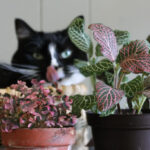Learning How Do You Draw A Cat Step By Step is now simpler than ever, and at solcat.net, we’re thrilled to guide you through this creative journey with easy-to-follow instructions, making the process enjoyable and rewarding for cat lovers of all ages, plus you’ll unleash your inner artist. With our step-by-step approach, you’ll quickly learn to sketch adorable feline friends, capturing their unique charm and personality. Check out solcat.net for the ultimate experience in cat drawing tutorials, tips for creating realistic cat portraits, and simple cat sketches for beginners.
1. Why Learn How to Draw a Cat Step by Step?
Learning how to draw a cat step by step can be a rewarding and enjoyable experience. It’s a fantastic way to express your creativity, improve your artistic skills, and deepen your appreciation for these wonderful animals. Drawing cats can also be a calming and therapeutic activity. According to a study by the American Art Therapy Association, engaging in art can reduce stress and anxiety levels. Plus, once you’ve mastered the basics, you can create personalized artwork, gifts, or even design your own cat-themed merchandise.
- Express Your Creativity: Drawing allows you to translate your vision onto paper, fostering imagination and artistic expression.
- Improve Your Skills: Step-by-step drawing tutorials enhance your hand-eye coordination, attention to detail, and understanding of form and proportion.
- Create Personalized Art: Whether it’s a portrait of your own cat or a whimsical feline character, drawing allows you to create unique and meaningful artwork.
1.1. Benefits of Drawing for Cat Lovers
For cat lovers, drawing cats can be a particularly fulfilling activity. It allows you to connect with your feline companions on a deeper level, observing their unique features and capturing their individual personalities. It’s also a great way to celebrate your love for cats and share your passion with others. And at solcat.net, you’ll find a vibrant community of cat enthusiasts who share your interest in feline art and creativity.
- Deeper Connection with Cats: By observing and drawing cats, you’ll develop a greater appreciation for their beauty and unique characteristics.
- Personalized Cat Portraits: Create lasting memories of your beloved feline friends with custom-drawn portraits.
- Share Your Passion: Connect with other cat lovers and artists at solcat.net, sharing your artwork and inspiring others.
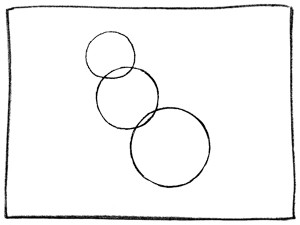 Cat head outline
Cat head outline
1.2. Drawing as a Therapeutic Activity
Engaging in art, including drawing, has been shown to have therapeutic benefits. A study published in the “Journal of the American Art Therapy Association” found that art therapy can significantly reduce anxiety, stress, and symptoms of depression. Drawing can also promote relaxation, improve focus, and boost self-esteem. It’s a wonderful way to unwind after a long day, express your emotions, and connect with your inner self.
- Reduces Stress and Anxiety: Drawing can have a calming effect on the mind, helping to alleviate stress and promote relaxation.
- Improves Focus: The act of drawing requires concentration and attention to detail, which can enhance your ability to focus.
- Boosts Self-Esteem: Completing a drawing can provide a sense of accomplishment and boost your confidence in your artistic abilities.
2. Essential Tools for Drawing Cats
Before you begin your cat drawing journey, it’s essential to gather the right tools. While you don’t need a lot of expensive equipment, having a few quality supplies can make a big difference in your results. Here are some essential tools to get you started:
- Pencils: A range of graphite pencils (e.g., HB, 2B, 4B, 6B) allows you to create different values and textures.
- Paper: Smooth drawing paper or sketchbooks are ideal for pencil drawings.
- Eraser: A kneaded eraser is perfect for lifting graphite without damaging the paper.
- Sharpener: Keep your pencils sharp to achieve fine details and clean lines.
- Blending Stumps: These tools help to create smooth transitions and soft shading.
2.1. Choosing the Right Pencils
The type of pencils you use can significantly impact the quality of your drawings. Graphite pencils are graded on a scale from H to B, with H pencils being harder and lighter, and B pencils being softer and darker. For drawing cats, it’s helpful to have a range of pencils to create different values and textures. According to art supply experts at Dick Blick Art Materials, a good starting set includes an HB pencil for light sketching, a 2B pencil for general drawing, and a 4B or 6B pencil for creating dark shadows.
| Pencil Grade | Characteristics | Best Use |
|---|---|---|
| HB | Medium hardness, good for general sketching | Light outlines, initial sketches |
| 2B | Slightly softer and darker than HB | General drawing, adding details |
| 4B | Soft and dark, creates rich shadows | Deep shadows, textures |
| 6B | Very soft and dark, ideal for creating dramatic contrasts | Darkest shadows, expressive lines |
2.2. Selecting the Best Paper
The type of paper you use can also affect the outcome of your drawings. Smooth drawing paper is ideal for pencil drawings, as it allows the graphite to glide easily and create smooth, even tones. Sketchbooks are also a great option, as they provide a convenient way to keep your drawings organized and protected. According to a guide by Jerry’s Artarama, look for paper that is acid-free and has a weight of at least 70 lb (110 gsm) to prevent it from buckling or tearing.
- Smooth Drawing Paper: Ideal for creating smooth, even tones and fine details.
- Sketchbooks: Provide a convenient way to keep your drawings organized and protected.
- Acid-Free Paper: Prevents the paper from yellowing or deteriorating over time.
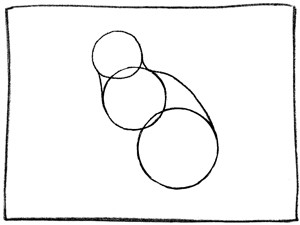 Cat neck and back outline
Cat neck and back outline
2.3. Other Useful Tools
In addition to pencils and paper, there are a few other tools that can be helpful for drawing cats. A kneaded eraser is perfect for lifting graphite without damaging the paper, allowing you to create highlights and correct mistakes. A sharpener is essential for keeping your pencils sharp, ensuring that you can achieve fine details and clean lines. Blending stumps are useful for creating smooth transitions and soft shading, adding depth and realism to your drawings.
- Kneaded Eraser: Lifts graphite without damaging the paper, ideal for creating highlights.
- Sharpener: Keeps your pencils sharp for fine details and clean lines.
- Blending Stumps: Creates smooth transitions and soft shading.
3. Step-by-Step Guide: How to Draw a Realistic Cat
Now that you have your tools ready, let’s dive into the step-by-step process of drawing a realistic cat. This guide will break down the process into manageable steps, making it easy for you to follow along and create your own stunning cat drawing. Remember, practice makes perfect, so don’t be afraid to experiment and have fun!
- Start with Basic Shapes: Begin by sketching simple shapes to outline the cat’s head and body. Use light, loose lines to create a circle for the head, an oval for the torso, and additional ovals for the legs.
- Refine the Outline: Connect the shapes to create a basic cat form. Pay attention to the proportions and curves of the cat’s body.
- Add Facial Features: Sketch the eyes, nose, and mouth. Observe the unique characteristics of a cat’s face, such as the shape of the eyes and the placement of the nose.
- Draw the Ears: Add the ears, paying attention to their shape and angle. Cats have a variety of ear shapes, so choose one that suits your cat’s breed or personality.
- Sketch the Tail: Add the tail, varying its length and position to create a sense of movement.
- Add Details: Refine the drawing by adding details such as fur texture, whiskers, and markings.
- Shade and Highlight: Use shading techniques to create depth and dimension. Observe how light and shadow play on the cat’s fur, and use your pencils to create realistic shading.
- Final Touches: Erase any unnecessary lines and add final details to complete your drawing.
3.1. Step 1: Basic Shapes
The first step in drawing a realistic cat is to create a basic framework using simple shapes. This will help you establish the proportions and pose of your cat before you start adding details. According to art instructor Giovanni Civardi, author of “Drawing and Sketching Portraits,” starting with basic shapes is a fundamental technique for creating accurate and well-proportioned drawings.
- Head: Draw a circle for the cat’s head.
- Torso: Add an oval for the cat’s torso, overlapping the head.
- Legs: Sketch additional ovals for the legs, positioning them to create the desired pose.
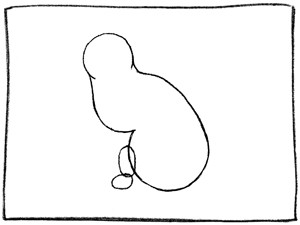 Cat front leg outline
Cat front leg outline
3.2. Step 2: Refining the Outline
Once you have your basic shapes in place, it’s time to refine the outline and create a more recognizable cat form. Connect the shapes with smooth, curving lines to create the cat’s neck, back, and belly. Pay attention to the proportions and curves of the cat’s body, and make adjustments as needed.
- Connect the Shapes: Use smooth, curving lines to connect the head, torso, and legs.
- Pay Attention to Proportions: Ensure that the cat’s body is in proportion, with the head being smaller than the torso.
- Adjust as Needed: Don’t be afraid to make adjustments to the outline as you go, ensuring that it accurately reflects the cat’s form.
3.3. Step 3: Adding Facial Features
The facial features are what give a cat its unique personality and expression. When drawing the eyes, nose, and mouth, pay close attention to their shape, size, and placement. According to feline behaviorist Jackson Galaxy, author of “Total Cat Mojo,” understanding cat anatomy and facial expressions can help you capture their essence in your drawings.
- Eyes: Draw the eyes, paying attention to their shape and angle. Cats have a variety of eye shapes, from round to almond-shaped.
- Nose: Sketch the nose, noting its size and shape. Cats have small, triangular noses that are often pink or black.
- Mouth: Add the mouth, paying attention to its shape and expression. Cats have a wide range of facial expressions, from playful to serious.
3.4. Step 4: Drawing the Ears
The ears are another important feature that contributes to a cat’s unique appearance. Cats have a variety of ear shapes, from pointed to rounded, and their ears can swivel and move to detect sounds. When drawing the ears, pay attention to their shape, angle, and position on the head.
- Shape: Choose an ear shape that suits your cat’s breed or personality.
- Angle: Pay attention to the angle of the ears, as this can convey different emotions.
- Position: Position the ears correctly on the head, ensuring that they are symmetrical and in proportion.
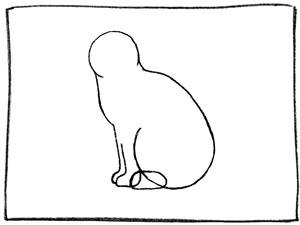 Cat other front leg outline
Cat other front leg outline
3.5. Step 5: Sketching the Tail
The tail is an expressive part of a cat’s anatomy, conveying a variety of emotions and intentions. When drawing the tail, vary its length and position to create a sense of movement and personality. According to “The Cat Behavior Answer Book” by Arden Moore, a cat’s tail can communicate a wide range of emotions, from happiness to fear.
- Length: Vary the length of the tail to create different poses and expressions.
- Position: Position the tail in a way that conveys the cat’s mood or intention.
- Movement: Add curves and bends to the tail to create a sense of movement.
3.6. Step 6: Adding Details
Once you have the basic outline and facial features in place, it’s time to add details that will bring your cat drawing to life. This includes adding fur texture, whiskers, and markings.
- Fur Texture: Use short, overlapping strokes to create the texture of the cat’s fur. Vary the length and direction of the strokes to create a realistic effect.
- Whiskers: Add long, smooth lines for the cat’s whiskers. Whiskers are an important sensory organ for cats, helping them navigate their environment.
- Markings: Add any distinctive markings or patterns that your cat may have. This could include stripes, spots, or patches of color.
3.7. Step 7: Shading and Highlighting
Shading and highlighting are essential techniques for creating depth and dimension in your drawings. By observing how light and shadow play on the cat’s fur, you can use your pencils to create realistic shading that will make your drawing come to life. According to “Light and Shade: The Complete Guide for Artists” by Giovanni Civardi, understanding the principles of light and shadow is crucial for creating realistic and believable drawings.
- Observe Light and Shadow: Pay attention to how light and shadow fall on the cat’s fur.
- Use Shading Techniques: Use a range of shading techniques, such as hatching, cross-hatching, and blending, to create different values and textures.
- Create Highlights: Use a kneaded eraser to lift graphite and create highlights, adding contrast and dimension to your drawing.
3.8. Step 8: Final Touches
The final step in drawing a realistic cat is to add any final touches that will complete your drawing. This could include erasing any unnecessary lines, adding subtle details, or refining the shading and highlighting.
- Erase Unnecessary Lines: Use a kneaded eraser to remove any lines that are no longer needed.
- Add Subtle Details: Add any subtle details that will enhance the realism of your drawing.
- Refine Shading and Highlighting: Make any final adjustments to the shading and highlighting to create a polished and professional-looking drawing.
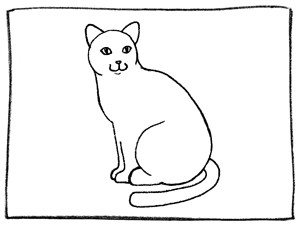 Cat face and ears outline
Cat face and ears outline
4. Tips and Tricks for Drawing Cats
Drawing cats can be challenging, but with practice and the right techniques, you can create stunning artwork that captures their unique beauty and personality. Here are some tips and tricks to help you improve your cat drawing skills:
- Use References: Use photographs or real-life observations as references to help you accurately capture the cat’s anatomy and features.
- Practice Regularly: The more you draw, the better you will become. Set aside time each day or week to practice your cat drawing skills.
- Experiment with Different Techniques: Try different drawing techniques, such as hatching, cross-hatching, and blending, to create different textures and effects.
- Join a Community: Connect with other artists and cat lovers online or in person to share your work, get feedback, and learn from others.
4.1. Using References Effectively
Using references is crucial for creating accurate and realistic drawings. When drawing cats, use photographs or real-life observations as references to help you capture their anatomy, features, and poses. According to “The Artist’s Complete Guide to Drawing the Head” by William Maughan, using references can significantly improve the accuracy and realism of your drawings.
- Photographs: Use photographs of cats as references to help you capture their anatomy, features, and poses.
- Real-Life Observations: Observe cats in real life to study their movements, expressions, and behaviors.
- Combine References: Use a combination of photographs and real-life observations to create a well-rounded understanding of cat anatomy and behavior.
4.2. Practicing Regularly
Practice makes perfect when it comes to drawing. The more you draw, the better you will become. Set aside time each day or week to practice your cat drawing skills. Even if you only have a few minutes to spare, consistent practice can make a big difference in your progress.
- Set a Schedule: Set aside specific times for drawing each day or week.
- Start Small: Begin with short drawing sessions and gradually increase the length as you become more comfortable.
- Focus on Improvement: Don’t focus on perfection, but rather on improving your skills with each drawing.
4.3. Experimenting with Techniques
Experimenting with different drawing techniques can help you create a variety of textures and effects in your cat drawings. Try hatching, cross-hatching, blending, and other techniques to see what works best for you.
- Hatching: Use parallel lines to create shading and texture.
- Cross-Hatching: Use intersecting lines to create darker values and more complex textures.
- Blending: Use blending stumps or your fingers to create smooth transitions and soft shading.
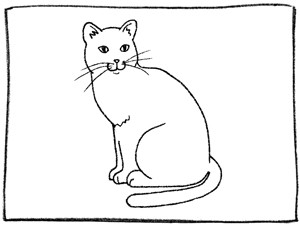 Cat whiskers and tails
Cat whiskers and tails
4.4. Joining a Community
Connecting with other artists and cat lovers can be a great way to improve your drawing skills, share your work, and get feedback. Join an online forum, attend a local art class, or connect with other artists in your community.
- Online Forums: Join online forums or social media groups dedicated to cat drawing or art in general.
- Art Classes: Attend local art classes or workshops to learn new techniques and get feedback from instructors.
- Local Artists: Connect with other artists in your community to share your work, get feedback, and collaborate on projects.
5. Advanced Techniques for Cat Drawings
Once you’ve mastered the basics of drawing cats, you can explore advanced techniques to take your artwork to the next level. These techniques include creating realistic fur textures, capturing expressive eyes, and mastering dynamic poses.
- Realistic Fur Textures: Learn how to create realistic fur textures using a variety of shading and linework techniques.
- Expressive Eyes: Capture the unique sparkle and personality of a cat’s eyes with detailed shading and highlighting.
- Dynamic Poses: Draw cats in dynamic and interesting poses that convey movement and emotion.
5.1. Creating Realistic Fur Textures
Creating realistic fur textures is essential for bringing your cat drawings to life. Use a variety of shading and linework techniques to create the illusion of soft, fluffy fur. According to “Drawing Furries: How to Create Anthropomorphic Animals” by Lindsay Cibos and Jared Hodges, understanding fur direction and texture is crucial for creating realistic animal drawings.
- Fur Direction: Pay attention to the direction of the fur, following the contours of the cat’s body.
- Layering: Use multiple layers of shading to create depth and dimension in the fur.
- Individual Strands: Add individual strands of fur to create a more realistic texture.
5.2. Capturing Expressive Eyes
The eyes are the window to the soul, and this is especially true for cats. Capturing the unique sparkle and personality of a cat’s eyes can make your drawings more engaging and lifelike.
- Shape and Angle: Pay attention to the shape and angle of the eyes, as this can convey different emotions.
- Highlights: Add small highlights to the eyes to create a sense of sparkle and life.
- Shading: Use subtle shading around the eyes to create depth and dimension.
5.3. Mastering Dynamic Poses
Drawing cats in dynamic and interesting poses can convey movement, emotion, and personality. Use references to help you capture the anatomy and balance of the cat in different poses.
- Action Lines: Use action lines to capture the movement and energy of the cat’s pose.
- Balance: Pay attention to the balance of the cat’s body, ensuring that the pose looks natural and believable.
- Foreshortening: Use foreshortening techniques to create the illusion of depth and perspective in your drawings.
6. Resources for Cat Lovers and Artists at Solcat.net
Solcat.net is your ultimate online destination for cat lovers and artists. Whether you’re looking for information on cat breeds, care tips, or art tutorials, Solcat.net has everything you need to celebrate your love for cats.
- Cat Breed Information: Learn about different cat breeds, their characteristics, and care requirements.
- Cat Care Tips: Get expert advice on feeding, grooming, health, and behavior to ensure your cat is happy and healthy.
- Art Tutorials: Access a wide range of art tutorials, including step-by-step guides on drawing cats and other animals.
- Community Forum: Connect with other cat lovers and artists in our online community forum, where you can share your work, get feedback, and make new friends.
6.1. Cat Breed Information
Solcat.net provides comprehensive information on a wide range of cat breeds, including their history, characteristics, and care requirements. Whether you’re looking for a playful and active cat or a calm and affectionate companion, Solcat.net can help you find the perfect breed for your lifestyle.
- Popular Breeds: Learn about popular cat breeds such as Persians, Siamese, Maine Coons, and Bengals.
- Rare Breeds: Discover rare and exotic cat breeds such as Turkish Angoras, Scottish Folds, and Sphynx cats.
- Breed Comparison: Compare different cat breeds to find the one that best suits your preferences and lifestyle.
6.2. Cat Care Tips
Solcat.net offers expert advice on all aspects of cat care, including feeding, grooming, health, and behavior. Whether you’re a first-time cat owner or an experienced caregiver, Solcat.net can help you provide the best possible care for your feline companion.
- Feeding: Learn about the best diets for cats, including dry food, wet food, and raw food options.
- Grooming: Get tips on grooming your cat’s fur, including brushing, bathing, and nail trimming.
- Health: Learn about common cat health problems and how to prevent them.
- Behavior: Understand your cat’s behavior and learn how to address common issues such as scratching, biting, and spraying.
6.3. Art Tutorials
Solcat.net features a wide range of art tutorials, including step-by-step guides on drawing cats and other animals. Whether you’re a beginner or an experienced artist, you’ll find tutorials that will help you improve your skills and create stunning artwork.
- Beginner Tutorials: Start with basic tutorials that teach you the fundamentals of drawing cats.
- Advanced Tutorials: Explore advanced techniques such as creating realistic fur textures and capturing expressive eyes.
- Guest Artists: Learn from guest artists who share their unique techniques and insights on drawing cats.
6.4. Community Forum
Connect with other cat lovers and artists in the Solcat.net community forum. Share your work, get feedback, ask questions, and make new friends who share your passion for cats and art.
- Share Your Artwork: Post your cat drawings and get feedback from other artists.
- Ask Questions: Get answers to your cat care and art-related questions.
- Make New Friends: Connect with other cat lovers and artists from around the world.
7. Real-World Applications of Cat Drawings
Learning how to draw cats can open up a world of creative possibilities, from creating personalized artwork and gifts to designing cat-themed merchandise. Here are some real-world applications of cat drawings:
- Personalized Artwork: Create custom portraits of your own cats or draw cats for friends and family.
- Gifts: Give unique and meaningful gifts, such as hand-drawn cat portraits or cat-themed cards.
- Merchandise: Design and sell cat-themed merchandise, such as t-shirts, mugs, and phone cases.
- Illustrations: Use your cat drawings to illustrate children’s books, magazines, or websites.
7.1. Personalized Artwork
Creating personalized artwork is a great way to celebrate your love for cats and create lasting memories of your feline companions. Draw custom portraits of your own cats or create artwork for friends and family who are also cat lovers.
- Pet Portraits: Draw realistic portraits of cats, capturing their unique features and personalities.
- Cartoon Cats: Create whimsical and fun cartoon cats for a more lighthearted approach.
- Abstract Cats: Experiment with abstract styles to create unique and eye-catching cat artwork.
7.2. Gifts
Hand-drawn cat portraits or cat-themed cards make unique and meaningful gifts for cat lovers of all ages. These personalized gifts are sure to be treasured for years to come.
- Cat Portraits: Give a hand-drawn portrait of a friend or family member’s cat as a special gift.
- Cat-Themed Cards: Create handmade cards featuring cat drawings for birthdays, holidays, or other special occasions.
- Custom Artwork: Design custom artwork featuring cats for a truly unique and personalized gift.
7.3. Merchandise
If you’re looking to turn your cat drawing skills into a business venture, consider designing and selling cat-themed merchandise. T-shirts, mugs, phone cases, and other items featuring your cat drawings can be popular sellers online or at local craft fairs.
- T-Shirts: Design t-shirts featuring your cat drawings for cat lovers to wear and show off their passion.
- Mugs: Create mugs featuring cat drawings for people to enjoy their morning coffee or tea.
- Phone Cases: Design phone cases featuring cat drawings for cat lovers to protect their phones in style.
7.4. Illustrations
If you have a knack for storytelling, consider using your cat drawings to illustrate children’s books, magazines, or websites. Cat illustrations can add charm and appeal to any publication.
- Children’s Books: Illustrate children’s books featuring cats as the main characters.
- Magazines: Create cat illustrations for magazines that feature articles about cats and cat care.
- Websites: Design cat illustrations for websites that cater to cat lovers.
8. Inspiring Cat Artists and Their Work
To further inspire your cat drawing journey, let’s take a look at some inspiring cat artists and their work. These artists have mastered the art of capturing the beauty, personality, and charm of cats in their artwork.
- Louis Wain: A British artist known for his whimsical and anthropomorphic cat illustrations.
- Susan Herbert: An artist who recreates famous paintings using cats as the subjects.
- Endre Penovac: A Hungarian artist who creates stunning watercolor paintings of cats.
8.1. Louis Wain
Louis Wain was a British artist known for his whimsical and anthropomorphic cat illustrations. His early works featured realistic depictions of cats, but as he developed schizophrenia, his cat illustrations became increasingly abstract and psychedelic. Despite his mental illness, Wain’s cat illustrations remain popular and are celebrated for their unique style and charm.
- Whimsical Style: Wain’s cat illustrations are characterized by their whimsical and playful style.
- Anthropomorphism: Wain often depicted cats with human-like qualities, such as wearing clothes and engaging in human activities.
- Abstract Art: Wain’s later works featured increasingly abstract and psychedelic depictions of cats.
8.2. Susan Herbert
Susan Herbert was an artist who recreated famous paintings using cats as the subjects. Her humorous and imaginative interpretations of classic works of art have earned her a devoted following.
- Humorous Interpretations: Herbert’s cat recreations of famous paintings are known for their humor and wit.
- Imaginative Approach: Herbert’s artwork showcases her imaginative approach to art history.
- Devoted Following: Herbert’s unique and charming artwork has earned her a devoted following among art lovers and cat enthusiasts.
8.3. Endre Penovac
Endre Penovac is a Hungarian artist who creates stunning watercolor paintings of cats. His delicate and ethereal paintings capture the grace, elegance, and mystery of cats.
- Watercolor Technique: Penovac’s watercolor technique creates soft and ethereal effects in his paintings.
- Grace and Elegance: Penovac’s paintings capture the grace and elegance of cats.
- Mystery: Penovac’s artwork evokes a sense of mystery and intrigue.
9. Common Mistakes to Avoid When Drawing Cats
While drawing cats can be a rewarding experience, it’s important to be aware of common mistakes that can hinder your progress. By avoiding these pitfalls, you can improve your skills and create more realistic and compelling cat drawings.
- Disproportionate Anatomy: Pay attention to the proportions of the cat’s body, ensuring that the head, torso, and limbs are in the correct ratio.
- Lack of Detail: Add details such as fur texture, whiskers, and markings to bring your cat drawings to life.
- Flat Shading: Use a variety of shading techniques to create depth and dimension in your drawings, avoiding flat and lifeless shading.
- Ignoring References: Use references to help you accurately capture the cat’s anatomy, features, and poses.
9.1. Disproportionate Anatomy
One of the most common mistakes when drawing cats is creating disproportionate anatomy. It’s essential to pay attention to the proportions of the cat’s body, ensuring that the head, torso, and limbs are in the correct ratio. Use references to help you accurately capture the cat’s anatomy.
- Head Size: Ensure that the head is in proportion to the body. The head should be smaller than the torso.
- Limb Length: Pay attention to the length of the limbs, ensuring that they are in proportion to the body.
- Torso Shape: Accurately depict the shape of the torso, paying attention to the curves and contours.
9.2. Lack of Detail
Another common mistake is failing to add details to your cat drawings. Details such as fur texture, whiskers, and markings can bring your drawings to life and make them more realistic.
- Fur Texture: Use short, overlapping strokes to create the texture of the cat’s fur.
- Whiskers: Add long, smooth lines for the cat’s whiskers.
- Markings: Add any distinctive markings or patterns that your cat may have.
9.3. Flat Shading
Flat shading can make your cat drawings look lifeless and unrealistic. Use a variety of shading techniques to create depth and dimension in your drawings.
- Hatching: Use parallel lines to create shading and texture.
- Cross-Hatching: Use intersecting lines to create darker values and more complex textures.
- Blending: Use blending stumps or your fingers to create smooth transitions and soft shading.
9.4. Ignoring References
Ignoring references is a common mistake that can lead to inaccurate and unrealistic cat drawings. Use photographs or real-life observations as references to help you accurately capture the cat’s anatomy, features, and poses.
- Photographs: Use photographs of cats as references to help you capture their anatomy, features, and poses.
- Real-Life Observations: Observe cats in real life to study their movements, expressions, and behaviors.
- Combine References: Use a combination of photographs and real-life observations to create a well-rounded understanding of cat anatomy and behavior.
10. Frequently Asked Questions (FAQs) About Drawing Cats
Here are some frequently asked questions about drawing cats, along with helpful answers to guide you on your creative journey:
- What are the essential tools for drawing cats? The essentials include graphite pencils (HB, 2B, 4B, 6B), smooth drawing paper, a kneaded eraser, a sharpener, and blending stumps.
- How do I start drawing a realistic cat? Begin by sketching simple shapes for the cat’s head and body, then refine the outline, add facial features, and gradually add details.
- What are some tips for creating realistic fur texture? Use short, overlapping strokes, follow the fur direction, and layer the shading to create depth and dimension.
- How can I capture the expressiveness of a cat’s eyes? Pay attention to the shape, angle, and highlights of the eyes, and use subtle shading to create depth and dimension.
- What are some common mistakes to avoid when drawing cats? Avoid disproportionate anatomy, lack of detail, flat shading, and ignoring references.
- Where can I find inspiration for drawing cats? Look at the works of cat artists like Louis Wain, Susan Herbert, and Endre Penovac, and observe cats in real life or in photographs.
- What’s the best way to practice drawing cats? Set aside time each day or week to practice, use references, and experiment with different techniques.
- How can I create dynamic poses in my cat drawings? Use action lines, pay attention to balance, and use foreshortening techniques to create the illusion of depth.
- Are there any online resources for learning how to draw cats? Yes, websites like solcat.net offer art tutorials, tips, and a community forum for cat lovers and artists.
- How can I turn my cat drawings into a business? Design and sell cat-themed merchandise, create personalized artwork for clients, or illustrate books and magazines.
By following these tips and practicing regularly, you’ll be well on your way to creating beautiful and realistic cat drawings. Don’t forget to visit solcat.net for more resources, inspiration, and a community of fellow cat lovers and artists.
Call to Action
Ready to unleash your inner artist and create stunning cat drawings? Visit solcat.net today for a wealth of resources, including step-by-step tutorials, expert tips, and a vibrant community of cat lovers and artists. Whether you’re a beginner or an experienced artist, solcat.net has everything you need to take your cat drawing skills to the next level. Join our community, share your work, and discover the joy of capturing the beauty and personality of cats on paper. Don’t wait – start your cat drawing journey with solcat.net today!
Address: 950 Alaskan Way, Seattle, WA 98104, United States. Phone: +1 (206) 386-4000. Website: solcat.net.

